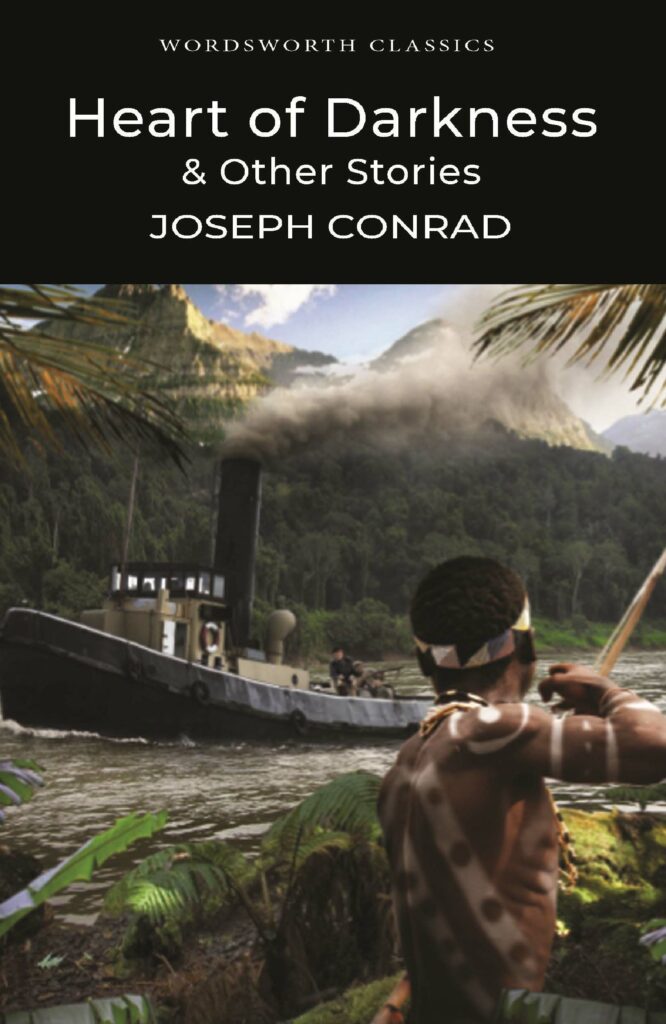
David Stuart Davies looks at Heart of Darkness
David Stuart Davies looks at Joseph Conrad’s controversial novella ‘ Heart of Darkness’.
‘We live in the flicker – may it last as long as the old earth keeps rolling! But darkness was here yesterday.’
There is no doubt that Heart of Darkness is an intriguing, dramatic and at times puzzling novella. It has been described as a riddling parable of imperialism, racism, self-discovery and self-destruction. Also central to the narrative is the notion that there is little difference between so-called civilised people and those described as savages. These contradictory themes have made the novel a fascinating but at times challenging read.
The author, Joseph Conrad (1857 – 1924) was born in Ukraine, the child of Polish parents. Conrad had a strong desire to go to sea and in 1874 travelled to Marseilles where he began a twenty-year career as a sailor. Although in later life Conrad discouraged the theory that his own nautical adventures provided the material for his novels, it is all too clear that his experiences at sea infuse their way into his fiction. Certainly, this is the case with Heart of Darkness. In 1890, Conrad served as captain of a river steamer in the Congo, a rich period which gave him the background material and the stimulation for this novella.
Heart of Darkness is the story of an English seaman, Charles Marlow, who is hired by a Belgian company to captain a river steamer in the recently established Congo Free State. Almost as soon as he arrives in the Congo, Marlow begins to hear rumours about another company employee, Kurtz, who is stationed deep in the interior of the country, hundreds of miles up the Congo River. The Westerners he encounters on his journey are interested only in extracting ivory and are oblivious of the suffering and deprivation of the indigenous native workers involved in this trade. Marlow tells his story to friends aboard a boat anchored on the River Thames – the use of two great rivers is significant. This setting provides the frame for the story of his obsession with the ivory trader Kurtz, which enables Conrad to create a parallel between what Conrad calls ‘the greatest town on earth’, London, and Africa which is presented as places of darkness. In doing so, Conrad is raising the question, ‘What is civilisation?’.
Marlow is sent up the river to rescue Kurtz who is now seriously ill. The ivory trader’s commercial success is matched by his reputation for idealism, but Marlow is dismayed to discover that Kurtz has made himself the natives’ god and is worshipped as such. His shocking depravity is signalled by the human heads which decorate the posts outside his hut. This discovery reflects the atrocities Conrad himself witnessed in Congo as it suffered under the colonial administration of the Belgians. While Kurtz is a multi-talented man – painter, musician and writer – he is used by Conrad as a symbol of the corruption of imperialism. The author is said to have remarked that his story was based on ‘experience, pushed a little (and only very little) beyond the actual facts of the case’. The novel ends with Kurtz dying on the trip back to civilisation as the narrator muses about the darkness of the human psyche: ‘the heart of an immense darkness’.
Critic David Miller observed: ‘Once experienced, it is hard to let Heart of Darkness go. A masterpiece of surprise, of expression and psychological nuance, fury at colonial expansion and of how men make the least of life, the novella is like a poem, endlessly readable and worthy of rereading’.
Indeed, Conrad composed a story in which we see ourselves, darkly. Its relevance echoes forever, rich with an understanding of the human condition. The timelessness of the issues and passions explored make this a novella of great power.
However, it was not regarded so highly when it was first published. Renowned literary critic F. R. Leavis referred to the novel as a ‘minor work’ and even Conrad did not consider it to be particularly notable. It was only after the author’s death that Heart of Darkness was re-evaluated and seen as a masterly blend of adventure, character development, and psychological penetration.
Now considered by many as Conrad’s finest, most enigmatic story, the novel finds a strong place in various lists of the best 100 novels ever written. It has influenced many writers including TS Eliot in his poem ‘The Hollow Men’ and the original epigraph for ‘The Waste Land’ was this passage from Heart of Darkness, which ends with Kurtz’s final words:
‘Did he live his life again in every detail of desire, temptation, and surrender during that supreme moment of complete knowledge? He cried in a whisper at some image, at some vision, – he cried out twice, a cry that was no more than a breath – ‘The horror! The horror!’’
There are also echoes of Conrad’s story found in Graham Green in the novel A Burnt-out Case.
Heart of Darkness has spawned numerous adaptations for film, radio and stage. Orson Welles starred in his own adaptation of the story in a CBS Radio broadcast on 6 November 1938 as part of his series, The Mercury Theatre on the Air. A year later the actor adapted it for his first film for RKO Pictures but the project was never realised. Perhaps the most interesting interpretation of Conrad’s novella is Francis Ford Coppola’s movie Apocalypse Now. The screenplay by John Milius, (who received an Oscar nomination for Best Adapted Screenplay) moves the story from late 19th-century Congo to Vietnam and Cambodia during the Vietnam War in the late 1960s. Martin Sheen plays Captain Benjamin L. Willard, a US Army Captain, Conrad’s Marlow character, whose task, unlike his literary counterpart, is to travel into the interior to ‘terminate the command’ of Colonel Walter E. Kurtz played by Marlon Brando.
Heart of Darkness has been widely republished and translated into many languages and continues to intrigue and prompt discussion and analysis.
Books associated with this article
